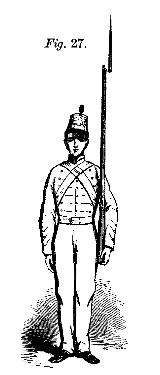
SCHOOL OF THE SOLDIER.
GENERAL RULES.
82. THE object of this School is the individual instruction
of the soldier; it should be taught with the greatest possible care
and precision, as on it depends the efficiency of the instruction of the
company, which is again so necessary to that of the battalion, and from
that of the battalion to the evolutions of the line, where an entire army
is maneuvered with as much precision as a single company.
The
instructor should never require a movement to be executed until he has
fully explained it, and joined example to precept by performing the movement
in person. He should accustom the soldier to take for himself the position
required, correcting him when necessary, and should abhor to prevent the
formation of a habit of carelessness in the execution of the movements.
Each
movement should be thoroughly understood before passing to another. After
they have been properly executed in the order laid down, the instructor
should no longer confine himself to that order. The men should be allowed
to rest for a few moments, frequently, in the earlier stages of their instruction,
and as often at other times as the instructor may think necessary to prevent
weariness, which is the prelude to carelessness. When they are at attention,
however, he should not allow any looking to the right or left; no changing
of position, or laughing, or whispering, etc., so common among volunteers
and militia. Here is the place to make the individual soldier, to give
him habits of attention, teach him subordination, etc. If he does not acquire
them in this school, it will be too late when he is advanced in the company.
At
the command REST, the soldier is no longer required to preserve
immobility, or to remain in his place. If the instructor wishes merely
to relieve the attention of the soldier, he commands, in place -
REST;
the soldier is then only required to keep one of his feet in place; if
he wishes to move that foot, the other is first brought up to its proper
position.
The
school
of the soldier is divided into three parts, the first comprehending
what ought to be taught to recruits without arms; the second, the manual
of arms, the loadings and firings; the third, the principles of alignment,
the march by the front, the different steps, the march by the flank, the
principles of wheeling, and those of change of direction. In this school,
the company is broken up into small squads, the number of men in each squad
being proportioned to the number of instructors; the squads for the first
and second part should be as small as possible, and the men placed in single
rank; for instruction in the third part, two or more squads of about equal
proficiency should be united.
------
PART FIRST.
In this part, the men should be without arm; and about one pace apart.
Position of the Soldier.
83. Heels on the same line, as near each other as the conformation of the
men will permit; because, if one were in rear of the other, the shoulder
on that side would be thrown back. The feet turned out equally, and forming
with each other something less than a right angle; because, if one foot
were turned out more than the other, a shoulder would be deranged, and
if both feet be too much turned out, it would not be practicable to give
the body its proper position. The knees straight, without stiffness; because,
if stiffened, constraint and fatigue would be unavoidable. The body erect
on the hips, inclining a little forward, because it gives stability to
the position. Soldiers are at first disposed to project the belly and throw
back the shoulders when they wish to hold themselves erect, from which
result many inconveniences in marching; it is, therefore, important that
the instructor should be particular to enforce this rule at the beginning.
The
shoulders square, and falling equally; if the shoulders are advanced beyond
the line of the breast, and the back arched, (the defect called round-shouldered,)
the
man cannot align himself nor use his piece with skill. In correcting this
defect, the instructor will take care that the shoulders are not thrown
too much to the rear, causing the body to project, and the small of the
back to curve.
The
arms hanging naturally; elbows near the body; palms of the hands turned
a little to the front, the little finger behind the seam of the pantaloons.
These positions are important to the shoulder-arms, to prevent
the man from occupying more space in ranks than is necessary, and to keep
the shoulders in proper position.
The
head erect, and square to the front, without constraint; the chin slightly
drawn in; the eyes fixed straight to the front, in order to prevent derangement
of the shoulders, and striking the ground at the distance of about fifteen
paces.
84. The instructor having given the squad the position of the soldier without
arms, will now teach the turning of the head and eyes. He will command
At
the word right, the soldier will turn his head gently, so
as to bring the inner corner of the left eye in a line with the buttons
of the coat, the eyes fixed on the line of the eyes of the men in the same
rank. At the command FRONT the head will resume the direct or habitual
position. The instructor will take care that the movement of the head does
not derange the squareness of the shoulders, and that the men do not acquire
a habit of throwing down the head in dressing.
The
movement of Eyes - LEFT will be executed by inverse means.
Facings.
85. Facing to the right and left will be executed in one time, or pause. The instructor commands:
1. Squad. 2. Right (or left) - FACE.
At the word FACE, raise the right foot slightly, turn
on the left reel, to the right (or left), raising the left
toe a little, and then replace the right heel beside the left, and on the
same line. The face should always be through a right angle, and should
be executed by the feet and legs, the body moving around to the right (or
left) without twisting or constraint. The instructor should labor to keep
the body steady, and to prevent the formation of the habit of bending the
knees, or springing.
86.
The full face to the rear is always to the right,
and is
executed in two times, or pauses. The instructor commands:
1. Squad. 2. ABOUT - FACE.
First
motion. At
the word about, the soldier will turn far enough on the
left heel to bring the left toe directly to the front, at the same time
carrying his right foot to the rear, the hollow opposite to, and full three
inches from the left heel, the feet square to each other. The back of the
right hand is placed a little above the right hip, and the body is turned
to the right sufficiently to give ease to the position.
Second
motion. At
the word face, the soldier raises his toes a little, turns upon both heels,
faces to the rear, keeping his legs straight, and draws back the right
heel by the side of the left, at the same time dropping his right hand
by his side.
Balance Step.
87. Before commencing the march the soldier should always be Instructed
in the balance step, the object of which is to teach him the free movement
of his limbs, while he at the same time preserves perfect squareness of
the shoulders, with the greatest steadiness of the body; no labor should
be spared to attain this object, which lies at the very foundation of good
marching.
The
squad being at attention, the instructor commands:
Left foot -FORWARD.
At
this command the soldier will throw his left foot gently forwards, about
twenty-four inches, balancing his body well on the right foot without changing
the position of the shoulders, and with out the body losing its erect position.
The toe should be turned out as in the position of the soldier, the foot
about three inches from the ground and very nearly parallel to it, the
toe being very slightly depressed.
At
the command:
Left foot -REAR.
The
left foot is brought gently back, the ball of the left foot close to the
right heel, the leg straight, toe raised, and heel depressed.
As
soon as the soldier becomes steady in the new position, the instructor
repeats the command, left foot forward,
then
left
foot rear, for several times, and then commands:
at which the left foot,
either advanced or to the rear, is brought to the right, as in the position
of the soldier.
The
instructor then causes the soldier to balance on the right foot, by advancing
and retiring the right, as has been directed for the left.
88. After the soldier is sufficiently instructed in the balance step to execute it on either foot without losing his balance, the instructor will proceed to instruct him in the mechanism of the direct step For this purpose he will command:
1. By the numbers - Forward. 2. ONE.
At the command one, the soldier will throw forward the left foot as in the position of left foot forward, the instructor then commands:
At
this command, the weight of the body is thrown forward, the left foot striking
the ground without shock, at the distance of twenty-eight inches from the
right; the body assumes the perpendicular position, and the right foot
is brought up to the position of right foot rear.
The
right foot is then brought forward at the command one,
and
the step completed at the command two; thus the squad is
made to advance step by step. The halt is executed as in
the balance step.
89.
When the squad is sufficiently instructed in the mechanism of the direct
step, the instructor will cause it to take up the march it common time;
for this purpose he will command:
1. Squad forward - Common time. 2. MARCH.
At
the command forward, the soldier will throw the weight of
his body on the right leg, without bending the left knee.
At
the command march, he will smartly, but without a jerk, carry
straight forward the left foot twenty-eight inches from the right, the
sole near the ground, the leg extended, the toe a little depressed, and
both it and the knee slightly turned out; he will at the same time throw
the weight of the body forward, and plant flat the left foot without shock,
precisely at the distance where it finds itself from the right when the
weight of the body is brought forward, the whole of which will now rest
on the left foot. The soldier will next in like manner, advance the right
foot and plant it as directed in the left, the heel twenty-eight inches
from the heel of the left foot, and thus continue the march without crossing
the legs, or striking one against the other, without turning the shoulders,
and always preserving the face direct to the front Common time is executed
at the rate of ninety steps to the minute.
When
the instructor wishes to arrest the march he commands:
1. Squad. 2. HALT.
The
command halt should be given just as one foot has come to
the ground, and the other is raised for making the next step; the soldier
instinctively completes the pace with the raised foot, and brings the other
firmly to its place beside it. By careful attention to this rule a large
command may be as readily halted at the same instant, as a single individual.
90.
The principles of the step in quick time are the same as for common time;
it is executed, however, at the rate of 110 steps per minute. After the
soldier is well established in the length and swiftness of the step at
common time, he should be practised in quick time, as it is the pace best
adapted to marches, the maneuvers, etc.
The
instructor wishing the squad to march in quick time, commands
1. Squad forward. 2. MARCH.
Principles of the Double Quick Step.
91.
The length of the double quick step is thirty-three inches, and its swiftness
is at the rate of 165 steps per minute. This step is designed especially
for light troops, such as light infantry an riflemen, and to them it is
indispensable; its utility has, however. been so frequently demonstrated
of late years, as to make it proper that it should form a part of the instruction
of all infantry troops.
The
instructor wishing to teach his squad the principles and mechanism of the
double quick step, commands:
1. Double quick step. 2. MARCH.
At
the command double quick step, the soldier will raise his
hands to a level with his hips, the hands closed, the nails towards the
body, the elbows to the rear and well drawn in towards the body.
At
the command march, he will raise his left knee as high as
possible without derangement of the body, keeping his leg from the knee
down in a vertical position, the toe depressed; he will then replace his
foot in its former position. At the command two, he will
execute with the right leg what has just been prescribed for the left,
and the alternate movement of the legs at the commands one, two,
will
be continued until the command:
1. Squad. 2. HALT.
At
the command halt, the soldier will bring the foot which is
raised by the side of the other, and at the same time dropping his hands
by his side will resume the position of the soldier without arms.
When
the squad has learned to execute the step properly, the instructor will
repeat the words one, two, in more rapid succession,
and will finally drop them, leaving the files to execute the step in their
own time. The instructor will see that the step is taken in rapid succession,
and that none of the files lose the step.
92.
The soldier being sufficiently established in the principles of this step,
the instructor will command:
1. Squad, forward. 2. Doublequick. 3. MARCH.
At
the command forward, the soldier will throw the weight of
his body on the right leg, without bending the left knee.
At
the command double quick, he will place his arms as indicated
above.
At
the command march, he will carry forward the left foot, and
plant it, the toe first, at the distance of thirty-three inches from the
right, the leg slightly bent, and the knee somewhat raised; he will then
execute with the right foot what has just been prescribed for the left.
This alternate movement of the legs will take place by throwing the weight
of the body on the foot that is planted, and by allowing a natural, oscillatory
motion to the arms. The feet should not be raised too much, a common fault
with beginners, and the body should incline slightly forward.
The
double quick step may be executed with different degrees of swiftness.
Under urgent circumstances, the cadence of this step may be increased to
180 per minute. At this rate a distance of 4000 yards would be passed over
in about twenty-five minutes.
The
men should also be exercised in running; the principles are the same as
for the double quick step, the only difference consisting in a greater
degree of swiftness.
It
is recommended in marching in double quick time, or the run, that the men
should breathe as much as possible through the nose, keeping the mouth
closed.
------
PART SECOND.
General Rules.
93. The instructor will not pass the soldiers to this second part until
they are well established in the position of the body, and in the manner
of marching at the different steps.
In
the manual of arms each command will be executed in one time(or
pause), but this time will be divided into motions, the better to make
known the mechanism, and to secure uniformity and precision in the
movements.
The
rate (or swiftness) of each motion, in the manual of arms, is fixed at
the ninetieth part of a minute; but the instructor will, at first, look
more particularly to the execution of the motions, without requiring a
nice observance of the cadence, to which he will bring the men progressively,
and after they have become a little familiarized with the use of the weapon.
The
motions relative to the cartridge, to the rammer, and to the firing and
unfixing of the bayonet, cannot be executed at the rate prescribed; or
even with uniform swiftness; the instructor will however, labor to have
these motions executed with promptness and regularity.
The
last syllable of the command will decide the brisk execution of the first
motion of each time (or pause). The commands two, three,
and
four,
will
decide the brisk execution of the other motions. As soon as the men comprehend
well the positions of the several motions of a time, they will be taught
to execute the time without resting on its motions; the mechanism of the
time must, however, be observed, as well to give perfect use to the weapon,
as to prevent carelessness or slighting of the motions. When the men have
acquired sufficient proficiency to execute the times without resting, the
instructor must be careful to have the proper cadence observed; great promptness
in the execution of the motions is not incompatible with the observance
of a pause between them, so that they may be executed at the prescribed
rate - that is, of ninety to the minute. Those instructors who insist most
upon the strict observance of this rule, are those whose squads execute
the manual in the best manner.
Principles of Shouldered Arms.
94. Each soldier being in the position of the soldier, the instructor will cause him to turn up the left hand without bending the wrist, the left fore-arm only acting. The instructor will raise the piece perpendicularly, and place it as follows:

(Fig.
27.) The piece in the left hand, the arm very slightly bent, the elbow
back near the body, the palm of the hand pressing on the outer flat of
the butt; the outer edge of the latter on the upper joints of the fingers,
the heel of the butt between the middle and fore-fingers, the thumb on
the front screw of the butt plate, the remaining fingers under the butt,
the butt more or less kept back according to the conformation of the man,
so that the piece, seen from the front, shall appear perpendicular, and,
also, that the movement of the thigh, in marching, may not raise it or
cause it to river; the stock, below the tail-band, resting against the
hollow of the shoulder, just within the joint, the right arm hanging naturally
as prescribed in the position of the soldier.
Soldiers
on first bearing arms are liable to derange their position, and particularly
to distort the shoulders, which, causing the musket to lose its point of
support, they drop the left hand to prevent the musket from falling from
the shoulder, which again causes that shoulder to droop, a curvature of
the side, spreading of the elbows etc. The instructor will be careful to
correct all these faults by continually rectifying the position; he will
avoid fatiguing the men too much in the beginning, but labor to render
this position natural and easy by degrees, that they may remain in it a
long time without fatigue.
The
instructor will also take great care that the musket be not carried too
high or too low; if too high, the left elbow would spread out, the soldier
would occupy too much space in ranks, and the musket would be unsteady;
if too low, the files would be too close, the man would not have the necessary
space to handle his musket with facility, the left arm would become too
much fatigued, the shoulder would droop, etc.
The
manual of the musket will be taught in the following order:
The instructor commands:
Support - Arms.
One time and three motions.
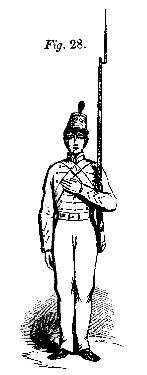
95.
First
Motion. (Fig. 28.) With the right hand seize the small of the stock
briskly, four inches below the lock, raising the piece a little, but not
turning it.
Second
Motion. Take
the left hand from the butt; extend the left fore-arm upward across the
body, and under the hammer, the left hand flat on the right breast.
Third
motion. Drop
the right arm smartly to its position. The squad being at support
arms, the instructor commands:
Carry - ARMS.
One time and three motions.
96.First
motion. Carry quickly the right hand to the small of the stock.
Second
motion. Place
the left hand under the butt, as in the position of shoulder arms.
Third
motion. Let
fall smartly the right hand to its position, and drop with the left, at
the same time, the piece into the position of shoulder arms.
Present - ARMS.
One time and two motions.
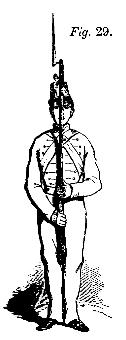
97.First
motion. (Fig. 29.) Turn the piece with the left hand, the lock
out, and seize the small of the stock at the same time with theright hand,
the piece perpendicular and detached from the shoulder, the left hand remaining
under the butt.
Second
motion. Complete
the turning inwards of the piece, so as to bring it erect before the centre
of the body, the rammer to the front the right hand under and against the
guard; seize it smartly at the same time with the left hand just above
the lock, the thumb extended along the barrel and on the stock, the left
fore-arm resting on the body without constraint, and the hand at the height
of the elbow.
Shoulder - ARMS.
One time and two motions.
98.
First
motion. Turn the piece with the right hand, the barrel to the front,
raise and support it against the left shoulder with the right hand, drop
the left under the butt, the right hand resting on, without grasping, the
small of the stock.
Second
motion. Drop
quickly the right hand into its position.
Order - ARMS.
One time and two motions.
99.
First
motion. Drop the piece smartly by extending the left arm, seize
it at the same time with the right hand, above and near the tail-band;
quit the hold of the left hand, and carry the piece opposite to the right
shoulder, the rammer to the front, the little finger behind the barrel,
the right hand supported against the hip. the butt three inches from the
ground, the piece erect, the left hand hanging by the side.
Second
motion. Let
the piece slip through the right hand to the ground without shock, and
take the position about to be described.
Position of Order Arms.
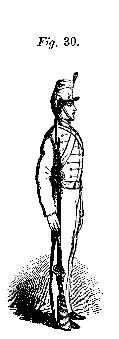
100.
(Fig. 30.) The hand low, the barrel between the thumb and forefinger extended
along the stock; the other fingers extended and joined; the muzzle about
two inches from the right shoulder; the rammer in front; the toe of the
butt against, and in a line with. the toe of the right foot, the barrel
perpendicular.
101.
When the instructor wishes to give repose in this position, he commands:
REST.
At
this command the soldiers will not be required to preserve silence or steadiness.
They, however, will not quit their rank without special permission.
102.
When the instructor wishes the men to pass from this position to that of
silence and steadiness, he commands:
1. Attention. 2. SQUAD.
At the second word, the men will reserve the position of order arms, and remain firm and silent.
Shoulder - ARMS.
One time and two motions.
103.
First
motion. Raise smartly the piece with the right hand, carryit against
the left shoulder, turning it, so as tobring the barrel to the front;
at the same time place the left hand under the butt, and slip the
right hand down to the lock.
Second
motion. Let the right hand fall briskly to its position.
Charge - BAYONET.
One time and two motions.
l04.
First
motion. Make a half face to the right on the left heel, bring the
left toe directly to the front, at the same time place the right foot behind,
and at right angles with the left, the hollow of right foot opposite to,
and about three inches from the left heel; turn the piece with the left
hand, the lock outwards, and seize the small of the stock at the same time
with the right hand, the musket perpendicular, and detached from the shoulder,
the left hand under the butt.
Second
motion. Bring
down the piece with the right hand, letting it fall firmly into
the left, the latter seizing it a little in advance of the tail band, the
barrel up, the left elbow near the body, the right hand against the hip,
the point of the bayonet as high as the eye (Fig. 31.)
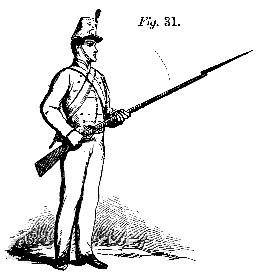
Shoulder - ARMS.
One time and two motions.
105.
First
motion. Face to the front by turning on the left heel bring up
the right by the side of the left heel; at the same time bring up the piece
with the right hand to the left shoulder, and place the left hand under
the butt.
Second
motion. Let
the right hand fall promptly into its position.
Load in ten times.
1. LOAD.
One time and two motions.
106.
First
motion. Drop the piece by a smart extension of the left arm, seize
it with the right hand above and near the lower band; at the same time
carry the right foot forward, the heel against the hollow of the left foot.
Second
motion. Drop
the piece with the right hand along the left thigh, seize it with the left
hand above the right, and with the left hand let it descend to the ground,
without shock, the piece touching the left thigh, and the muzzle opposite
the centre of the body; carry the right hand quickly to the cartridge-box
and open it. (Fig. 32.)
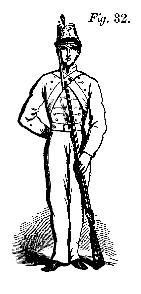
2. Handle - CARTRIDGE.
One time and one motion.
107. Seize a cartridge with the thumb and the next two fingers, and place it between the teeth.
3. Tear - CARTRIDGE.
One time and one motion.
l08. Tear the paper down to the powder, hold the cartridge upright between the thumb and two next fingers, near the top; in this position place it in front of and near the muzzle, the back of the hand to the front.
4. Charge - CARTRIDGE.
109. Fix the eye on the muzzle, turn quickly the back of right hand towards the body, in order to discharge the powder into the barrel, raise the elbow to the height of the wrist, shake the cartridge, force it into the muzzle, and leave the hand reversed, the fingers closed, but not clenched. (Fig. 33.)
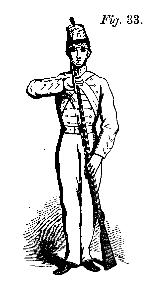
5. Draw - RAMMER.
One time and three motions.
110.
First
motion. Drop the right elbow smartly, and seize the rammer between
the thumb and fore-finger bent, the other fingers shut; draw it smartly,
extending the arm, seize the rammer again at the middle between the thumb
and fore-finger, the hand reversed, the palm to the front, the nails up,
the eyes following the movement of the hand, clear the rammer from the
pipes by again extending the arm.
Second
motion. Turn
rapidly the rammer between the bayonet and the face, closing the fingers,
the rammers of the rear rank grazing the right shoulders of the men of
the same file in front, the rammer parallel to the bayonet, the arm extended,
the butt of the rammer opposite to the muzzle but not yet inserted, the
eyes fixed on the muzzle.
Third
motion. Insert
the butt of the rammer, and force it down as low as the hand.
6. Ram - CARTRIDGE.
One time and one motion.
111. Extend the arm to its full length to seize the rammer between the right thumb extended and the fore-finger bent, the other fingers closed; with force ram home twice and seize the rammer at the small end between the thumb and fore-finger bent, the other fingers closed, the right elbow touching the body.
7. Return - RAMMER.
One time and three motions.
112. First
motion. Draw the rammer briskly, re-seize it at the middle between
the thumb and fore-finger, the hand reversed, the palm to the front, the
nails up, the eyes following the band, clear the rammer from the barrel
by extending the arm.
Second
motion. Turn the rammer rapidly
between the bayonet and the face, closing the fingers, the rammers of the
rear rank grazing the right shoulders of the men in
the same file in front, the rammer parallel to the bayonet,
the arm extended, the little end of the rammer opposite to the first pipe,
but not yet inserted, the eyes fixed on that pipe.
Third
motion. Insert the small end, and with the thumb, which will follow
the movement, force it, as low as the middle band; raise the hand quickly,
a little bent, place the little finger on the butt of the rammer, and force
it down; lower the left hand on the barrel to an extent of the arm without
depressing the shoulder.
8. Cast - ABOUT.
One time and two motions.
113.
First
motion. With the left hand bring up the piece vertically against
the left shoulder, seize it smartly with the right hand at the small of
the stock, and slide the left hand down as low as the chin.
Second
motion. Make
a half face to the right on the left heel, bring the left toe to
the front, place the right foot at the same time close behind, and at right
angles with the left, the hollow of the right foot against the left heel;
carry the piece opposite to the right shoulder; bring down the piece with
the right hand into the left, which will seize it at the tail band, the
thumb extended on the stock. the butt under the right for-arm the small
of the stock against the body, and about two inches under the right breast,
the muzzle at the height of the eye, the left elbow supported against the
side, the right hand grasping the small of the stock. (Fig. 34.)
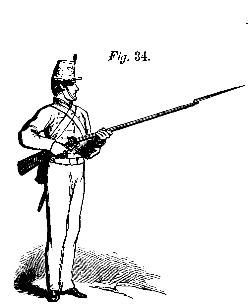
9. Prime.
One time and one motion.
114. Place the thumb of the right hand on the hammer (the fingers remaining under and against the guard), and half-cock the piece; brush off the old cap, and with the thumb and first two fingers of the right hand take a cap from the pouch, place it firmly on the cone by pushing it down with the thumb, and seize the piece by the small of the stock.
10. Shoulder - ARMS.
One time and two motions.
115.
First
motion. Face to the front by turning on the left heel; at
the same time bring the piece briskly with the right hand to the left shoulder,
and place the left hand under the butt.
Second
motion. Let
the right hand fall smartly into its position at shoulder
arms.
READY. (From the position of prime.)
One time and one motion.
116. Place the thumb of the right hand on the hammer (the fingers remaining under and against the guard), cock the piece, and seize the small of the stock.
READY. (From the position of shoulder arms.)
One time and four motions.
117.
First
motion. Turn the piece with the left hand, the lock to the front,
seize it at the small of the stock with the right hand; at the same time
make a half face to the right on the left heel, bringing the left toe to
the front and placing the right foot behind, and at right angles to the
left, the hollow of the foot against the left heel.
Second
motion. Bring
the piece with the right hand to the middle of the body, place the left
hand just above the lock, the thumb extending along the stock at the height
of the chin, the counter (or S)-plate turned towards the body,
the rammer obliquely to the left and front.
Third
motion. Place
the thumb on the hammer, the fore-finger under and on the guard, the other
three fingers joined to the first, the elbow at the height of the hand.
Fourth
motion.
Close the right elbow smartly to the body in cocking, without bending the
wrist, seize the piece by the small of the stock, let it descend along
the body in the left hand to the tail-band, which will remain at the height
of the shoulder. (Fig. 35.)

AIM.
One time and one motion.
118. Raise the butt to the shoulder, the left elbow a little down, shut the left eye, direct the right along the barrel, drop the head upon the butt to catch the object, and place the fore-finger on the trigger. The rear rank will at the same time, carry the right foot about eight inches towards the left heel of the man next on his right. (Fig. 36.)
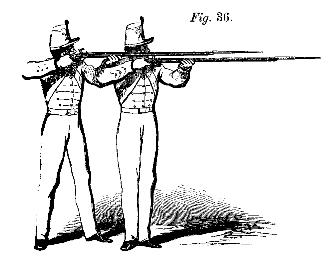
FIRE.
One time and one motion.
119. Apply the fore-finger with force to the trigger without further lowering or turning the head, and remain in that position.
LOAD. (From theFire.)
One time and two motions.
120.
First
motion. Bring back the piece quickly with both hands, depress the
butt strongly by extending the right arm, and carry it with the arm thus
extended to the left side, the barrel to the front and opposite to the
left shoulder, the left hand at the height of the chin, the back of the
hand to the front, the left for-arm touching the stock; at the same time
face to the front and carry the right foot forward, the heel against the
hollow of the left foot.
Second
motion. Let
go the handle with the right hand, let the piece descend through the left
to the ground, without shock, and take the position of the second motion
of load.
Shoulder - ARMS. (From the Fire.)
One time and two motions.
121.
First
motion. Bring back the piece with both hands, face to the front,
carry the piece against the left shoulder, and place the left hand under
the butt.
Second
motion. Let
the right hand fall smartly to its position.
The
squad being in the position of aim, the instructor, to habituate
the soldiers to wait for the word fire, sometimes commands:
Recover - ARMS.
One time and one motion.
122.
Withdraw the finger from the trigger, throw up the muzzle smartly, and
retake the position of the fourth motion of ready.
The
men being in this position, if the instructor wishes them to come to a
shoulder, he commands:
Shoulder - ARMS.
123. At the word shoulder, the squad will face to the front, and bring their pieces to the middle of the body again; the left thumb atthe height of the chin, the little finger just above the lock; next place the right thumb on the head of the hammer, support the fore-finger on the trigger, sustain the hammer carefully in its descent at the same time, to the position of half-cock, then seize the small of the stock with the right hand. At. the word arms, carry the piece to the shoulder smartly, and take the position of shoulder arms.
To load in four times (or pauses).
1. Load in four TIMES. 2. LOAD.
Execute the first time of loading, handle cartridge, tear cartridge, charge cartridge.
TWO.
125. Draw rammer, enter it as far as the hand, and ram twice.
THREE.
FOUR.
Unfix - BAYONETS.
One time and three motions.
First
motion. Drop
the piece by a smart extension of the left arm, seize it with the right
hand above and near the tail-band.
Second
motion. Drop
the piece with the right hand along the left thigh, seize it with the left
hand above the right, lengthen out the left arm, rest the butt on the ground,
without shock, and carry the right hand at the same time to the bayonet,
with the thumb lower the clasp against the stop, and then seize the bayonet
at the socket and shank.
Third
motion.
Wrest off the bayonet, return it to the scabbard, place the little linger
on the butt of the rammer, lower the left hand along the barrel in extending
the arm, without depressing the shoulder.
Shoulder - ARMS.
One time and three motions.
129.
First
motion. Raise the piece with the left hand along the left side,
the hand at the height of the chin, the fore-arm touching the piece, the
barrel to the front; drop at the same time the right hand to seize the
piece a little above the handle, the fore-fingrer touching the cock, and
the thumb on the counter-plate.
Second
motion. Raise
the piece with the right hand, drop the left, and place it under the butt,
bring back the right heel to the side of the left, and on the same line;
support the piece with the right hand against the shoulder, in the position
prescribed for shoulder arms, the right hand resting on,
without grasping, the piece.
Third
motion. Let
fall smartly the right hand into its position by the side of the
thigh.
Fix - BAYONET.
130.
First
and second motions. As the first and second motions of unfix
bayonet, except that at the end of the second motion, the right
hand will go to seize the bayonet by the socket and shank, so that the
lower (now upper) end of the socket shall extend about an inch above the
heel of the palm.
Third
motion. Draw
the bayonet from the scabbard, carry and fix it on the muzzle, turning
the clasp towards the body with the right thumb; place the little finger
on the head of the rammer lower the left hand along the barrel, in extending
the arm.
Shoulder - ARMS.
The same as from the unfix bayonet.
Secure - ARMS.
One time and two motions.
131.
First
motion. Seize quickly the piece with the right hand, the on the
counter-plate, and the fore-finger against the cock; detach the piece from
the shoulder at the same instant, the barrel to the front, seize it at
the tail-band with the left hand, the thumb extended on the rammer, the
piece erect, opposite to the shoulder, the left elbow on the piece.
Second
motion. Reverse
the piece, pass it under the left arm, the left hand remaining at
the tail-band, the thumb on the rammer to prevent it from sliding out,
the little finger resting against the hip, and the right hand falling at
the same time into its position. (Fig. 37.)
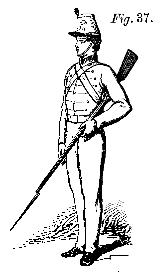
Shoulder - ARMS.
One time and two motions.
132.
First
motion. Raise the piece with the left hand, but not too suddenly,
lest the rammer should fly out; seize the handle with he right hand to
support it against the shoulder, quit the hold of the left hand, and place
quickly this hand under the butt.
Second
motion. Let
fall smartly the right hand into its position; drop at the same time the
piece into the position of shouldered arms.
Trail - ARMS.
One time and two motions.
133.
First
motion. As the first motion of order arms.
Second
motion. Incline
a little the muzzle to the front, the butt to the rear, and about three
inches from the ground, the right hand, supported at the hip, will sustain
the piece so that the men of the rear rank may not touch with their bayonets
the men in front of them. (Fig. 38.)
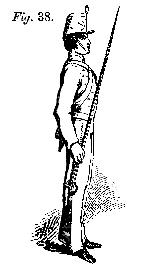
Shoulder - ARMS.
134. At the command shoulder, raise the piece perpendicularly in the right hand; at the command arms, execute what has been prescribed for the shoulder from the position of order arms.
To right shoulder, shift - ARMS.
One time and one motion.
135. Turn the piece with the left hand, the lock to the front, seize it at the same time with the right hand at the handle, place it on the right shoulder, the left hand not quitting the butt, the lock-plate upwards, the muzzle up; sustain the piece in this position by placing the right hand on the flat of the butt; let fall the left hand by the side. (Fig. 39.)
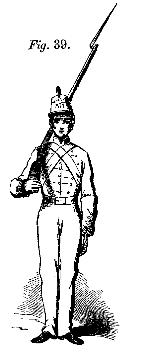
Shoulder - ARMS.
136. Raise the piece by extending the right arm, seize it with the left hand above the lock, carry it against the left shoulder. turning the barrel to the front, the right hand being at the handle, place the left hand under the butt, and let the right fall into its position.
Arms - AT WILL.
One time and one motion.
137. Carry the piece at pleasure on either shoulder, or with one or both hands, the muzzle always up.
Shoulder - ARMS.
138. Retake smartly the position of shoulder arms.
Inspection of Arms.
139. The squad being at ordered arms, and having the bayonet in the scabbard, if the instructor wishes to cause an inspection of arms, he will command:
Inspection of - ARMS.
One time and three motions.
First
motion. Face
to the right once and a half on the left heel, carrying the right
foot perpendicularly to the rear of the alignment, about six inches from,
and at right angles with, the left foot; seize promptly the piece with
the left hand a little above the middle band, incline the muzzle to the
rear without displacing the heel of the butt, the rammer turned towards
the body; carry at the same time the right hand to the bayonet and seize
it as has been prescribed, No.130.
Second
motion. Draw
the bayonet from the scabbard, carry and fix it on the muzzle; seize next
the rammer, draw it as has been explained in loading it twelve times, and
let it glide to the bottom of the bore.
Third
motion. Face
promptly to the front, seize the piece with the right hand, and retake
the position of ordered arms.
The
instructor will then inspect in succession the piece of each man, in passing
along the front of the rank. Each, as the instructor reaches him, will
raise smartly his piece with his right hand, seize it with the left between
the tail-band and the feather-spring, the lock to the front, the left hand
at the height of the chin, the piece opposite to the left eye (Fig. 40);
the instructor will take it with the right hand at the handle, and, after
inspecting it, will return it to the soldier, who will receive it back
with the right hand, and replace it in the position of ordered arms.
When
the instructor shall have passed him, each soldier will retake the position
prescribed at the command inspection of arms, and return
the rammer; after which he will face to the front.
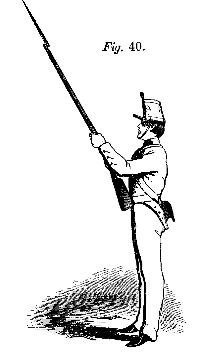
Fix - BAYONET.
Take
the position indicated, No.139, (first motion), fix bayonets as has been
explained, and immediately face to the front.
Bayonets
fixed, if it be the wish of the instructor, after firing, to ascertain
whether the pieces have been discharged, he will command:
Spring - RAMMERS.
Put
the rammer in the barrel, as has been explained above, and immediately
face to the front.
The
instructor, for the purpose stated, can take the rammer by the small end,
and spring it in the barrel, or cause each man to make the rammer ring
in the barrel.
Each
man, after the instructor passes him, will return rammer, and face to the
front.
Arms - PORT.
One time and one motion.
141. Throw the piece diagonally across the body, the lock to the front, seize it smartly at the same instant with both hands, the right at the handle, the left at the tail-band, the two thumbs pointing towards the muzzle, the barrel sloping upwards and crossing opposite to the point of the left shoulder, the butt proportionally lowered. The palm of the right hand will be above, and that of the left under the piece, the nails of both hands next to the body, to which the elbows will be dosed. (Fig. 41.)
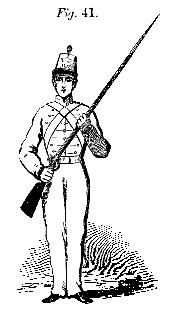
Shoulder - ARMS.
One time and two motions.
First
motion. Bring
the piece smartly to the left shoulder, placing the left hand under the
butt.
Second
motion. Drop
the right hand smartly by the side.
MANUAL OF ARMS FOR THE RIFLE.
Principles of Shouldered Arms.
142. The soldier standing in the position of the soldier, the instructor causes him to bend the right arm slightly, and places the piece in it, in the following manner: (Fig. 42.) The piece in the right hand - the barrel nearly vertical and resting in the hollow of the shoulder - the guard to the front, the arm hanging nearly at its full length near the body; the thumb and fore-finger embracing the guard, the remaining fingers closed together, and grasping the swell of the stock just under the cock, which rests on the little finger.
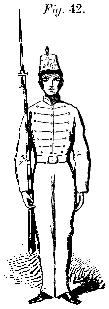
Support - ARMS.
One time and three motions.
143.
First
motion. Bring the piece, with the right hand, perpendicularly to
the front and between the eyes, the barrel to the rear; seize the piece
with the left hand at the lower band, raise this hand as high as the chin,
and seize the piece at the same time with the right hand four inches below
the cock.
Second
motion. Turn
the piece with the right hand, the barrel to the front; carry the piece
to the left shoulder, and pass the fore-arm extended on the breast between
the right hand and the cock; support the cock against the left fore-arm,
the left hand resting on the right breast.
Third
motion. Drop
the right hand by the side.
Shoulder - ARMS.
One time and three motions.
144.
First
motion.
Grasp the piece with the right hand under and against the
left fore-arm; seize it with the left hand at the lower band the thumb
extended; detach the piece slightly from the shoulder, the left fore-arm
along the stock.
Second
motion. Carry
the piece vertically to the right shoulder with both hands, the rammer
to the front, change the position of the right hand so as to embrace the
guard with the thumb and fore-finger, slip the left hand to the height
of the shoulder, the fingers extended and joined, the right arm nearly
straight.
Third
motion. Drop
the left hand quickly by the side.
Present - ARMS.
One time and two motions.
145.
First
motion. With the right hand bring the piece erect before the centre
of the body, the rammer to the front; at the same time seize the piece
with the left hand half-way between the guide sight and lower band, the
thumb extended along the barrel and against the stock, the fore-arm horizontal
and resting against the body, the hand as high as the elbow.
Second
motion. Grasp
the small of the stock with the right hand below and against the guard.
Shoulder - ARMS.
One time and two motions.
146.
First
motion. Bring the piece to the right shoulder, at the same time
change the position of the right hand so as to embrace the guard with the
thumb and fore-finger, slip up the left hand to the height of the shoulder,
the fingers extended and joined, the right arm nearly straight.
Second
motion. Drop
the left hand quickly by the side.
Order - ARMS.
One time and two motions.
147.
First
motion. Seize the piece briskly with the left hand nearthe upper
band, and detach it slightly from the shoulder with the right hand: loosen
the grasp of the right hand, lower the piece with the left, re-seize the
piece with the right hand above the lower band, the little finger in rear
of the barrel, the butt about four inches from the ground, the right hand
supported against the hip, drop the left hand by the side.
Second
motion.
Let the piece slip through the right hand to the ground by opening slightly
the fingers, and take the position about to be described.
Position of order arms.
148. The band low, the barrel between the thumb and fore-finger extended along the stock; the other fingers extended and joined; the muzzle about two inches from the right shoulder; the rammer in front; the toe (or beak) of the butt, against, and in a line with, the toe of the right foot, the barrel perpendicular.
Shoulder - ARMS.
One time and two motions.
149.
First
motion. Raise the piece vertically with the right hand to the height
of the right breast, and opposite the shoulder, the elbow close to the
body; seize the piece with the left hand below the right, and drop quickly
the right hand to grasp the piece at the swell of the stock, the thumb
and fore-finger embracing the guard; press the piece against the shoulder
with the left hand, the right arm nearly straight.
Second
motion. Drop
the left hand quickly by the side.
Load in nine times.
1. LOAD.
(Whenever
the loadings and firings are to be executed, the instructor will cause
cartridge boxes to be brought to the front.)
One time and one motion.
150. Grasp the piece with the left hand as high as the right elbow, and bring it vertically opposite the middle of the body, shift the right hand to the upper band, place the butt between the feet, the barrel to the front; seize it with the left hand near the muzzle, which should be three inches from the body; carry the right hand to the cartridge box. (Fig. 43.)
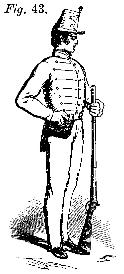
2. Handle - CARTRIDGE.
One time and one motion.
151. Seize the cartridge with the thumb and next two fingers, and place it between the teeth.
3. Tear - CARTRIDGE.
One time and one motion.
152. Tear the paper to the powder, hold the cartridge upright between the thumb and first two fingers, near the top; in this position place it in front of and near the muzzle - the back of the hand to the front.
4. Charge - CARTRIDGE.
One time and one motion.
153. Empty the powder into the barrel; disengage the ball from the paper with the right hand and the thumb and first two fingers of the left; insert it into the bore, the pointed end uppermost, and press it down with the right thumb; seize the head of the rammer with the thumb and fore-finger of the right hand, the other fingers closed, the elbows near the body.
5. Draw - RAMMER.
One time and three motions.
154.
First
motion. Half draw the rammer by extending the right arm; steady
it in this position with the left thumb; grasp the rammer near the muzzle
with the right hand, the little finger uppermost, the nails to the front,
the thumb extended along the rammer.
Second
motion. Clear
the rammer from the pipes by again extending the arm; the rammer in the
prolongation of the pipes.
Third
motion. Turn
the rammer, the little end of the rammer passing near the left shoulder;
place the head of the rammer on the ball, the back of the hand to the front.
6. Ram - CARTRIDGE.
One time and one motion.
155. Insert the rammer as far as the right, and steady it in this position with the thumb of the left hand; seize the rammer at the small end with the thumb and fore-finger of the right hand, the back of the hand to the front; press the ball home, the elbows near the body.
7. Return - RAMMER.
One time and three motions.
156.
First
motion. Draw the rammer half-way out, and steady it in this position
with the left thumb; grasp it near the muzzle with the right hand, the
little finger uppermost, the nails to the front, the thumb along the rammer;
clear the rammer from the bore by extending the arm, the nails to the front,
the rammer in the prolongation of the bore.
Second
motion. Turn
the rammer, the head of the rammer passing near the left shoulder, and
insert it in the pipes until the right hand reaches the muzzle, the nails
to the front.
Third
motion. Force
the rammer home by placing the little finger of the right hand on the head
of the rammer; pass the left hand down the barrel to the extent of the
arm, without depressing the shoulder
8. PRIME.
One time and two motions.
157.
First
motion. With the left hand raise the piece till the hand is as
high as the eye, grasp the small of the stock with the right hand; half
face to the right; place, at the same time, the right foot behind and at
right angles with the left; the hollow of the right foot against the left
heel. Slip the left hand down to the lower band, the thumb along the stock,
the left elbow against the body; bring the piece to the right side, the
butt below the right fore-arm - the small of the stock against the body
and two inches below the right breast, the barrel upwards, the muzzle on
a level with the eye.
Second
motion. Half
cock with the thumb of the right hand, the fingers supported against the
guard and the small of the stock - remove the old cap with one of the fingers
of the right hand, and with the thumb and fore-finger of the same hand
take a cap from the pouch, place it on the nipple, and press it down with
the thumb; seize the small of the stock with the right hand.
9. Shoulder - ARMS.
One time and two motions.
158.
First
motion. Bring the piece to the right shoulder, and support it
there with the left hand, face to the front; bring the right heel to the
side of and on a line with the left; grasp the piece with the right hand
as indicated in the position of shoulder arms.
Second
motion. Drop
the left hand quickly by the side.
READY.
One time and three motions.
159.
First
motion. Raise the piece slightly with the right hand, making a
half face to the right on the left heel; carry the right foot to the rear,
and place it at right angles to the left, the hollow of it opposite to,
and against the left heel; grasp the piece with the left hand at the lower
band and detach it slightly from the shoulder.
Second
motion. Bring
down the piece with both hands, the barrel upwards, the left thumb extended
along the stock, the butt below the right fore-arm, the small of the stock
against the body and two inches below the right breast, the muzzle as high
as the eye, the left elbow against the side; place at the same time the
right thumb on the head of the cock, the other fingers under and against
the guard.
Third
motion. Cock,
and seize the piece at the small of the stock without deranging the position
of the butt.
AIM.
160. As in the manual for the musket.
FIRE.
161. As in the manual for the musket.
LOAD.
One time and one motion.
162.
Bring down the piece with both hands, at the same time face to the front
and take the position of load. Each rear rank man will bright
his right foot by the side of the left.
The
men being in this position, the instructor will cause the loading to be
continued by the commands and means prescribed No. 151 and following.
If
after firing, the instructor should not wish the recruits to reload, he
will command:
Shoulder - ARMS.
One time and one motion.
163. Throw up the piece briskly with the left hand and resume the position of shoulder arms, at the same time face to the front, turning on the left heel, and bring the right heel on a line with the left.
Recover - ARMS.
164.
The same as in the manual for the musket.
165.
The soldiers being in the position of the third motion of ready,
if
the instructor should wish to bring them to a shoulder, he will command:
Shoulder - ARMS.
One time and one motion.
At
the command shoulder, place the thumb upon the cock, the
fore-finger on the trigger, half-cock, and seize the small of the stock
with the right hand. At the command arms, bring up the piece
briskly to the right shoulder, and retake the position of shoulder
arms.
The
recruits being at shoulder arms, when the instructor shall wish to fix
bayonets, he will command:
Fix - BAYONET.
One time and three motions.
166.
First
motion. Grasp the piece with the left hand at the height of the
shoulder, and detach it slightly from the shoulder with the right hand.
Second
motion. Quit
the piece with the right hand, lower it with the left hand, opposite
the middle of the body, and place the butt between the feet without shock;
the rammer to the rear, the barrel vertical, the muzzle three inches from
the body; seize it with the right hand at the upper band, and carry the
left hand reversed to the handle of the sabre-bayonet.
Third
motion. Draw
the sabre-bayonet from the scabbard and fix it on the extremity
of the barrel; seize the piece with the left hand, the arm extended, the
right hand at the upper band.
Shoulder - ARMS.
One time and two motions.
167.
First
motion. Raise the piece with the left hand and place it against
the right shoulder, the rammer to the front; seize the piece at the same
time with the right hand at the swell of the stock, the thumb and fore-finger
embracing the guard, the right arm nearly extended.
Second
motion. Drop
briskly the left hand by the side.
Charge - BAYONET.
One time and two motions.
168.
First
motion. Raise the piece slightly with the right hand andmake a
half face to the right on the left heel; place the hollow of the right
foot opposite to, and three inches from the left heel, the feetsquare;
seize the piece at the same time with the left hand a little above the
lower band.
Second
motion. Bring
down the piece with both hands, the barrel uppermost, the left elbow against
the body; seize the small of the stock, at the same time, with the right
hand, which will be supported against the hip; the point of the sabre-bayonet
as high as the eye.
Shoulder - ARMS.
One time and two motions.
169.
First
motion. Throw up the piece briskly with the left hand in facing
to the front, place it against the right shoulder, the rammer to the front;
turn the right hand so as embrace the guard, slide the left hand to the
height of the shoulder, the right hand nearly extended.
Second
motion. Drop
the left hand smartly by the side.
Trail- ARMS.
One time and two motions.
170.
First
motion. The same as the first motion of order arms.
Second
motion. Incline
the muzzle slightly to the front, the butt to the rear and about four inches
from the ground. The right hand supported at the hip, will so hold the
piece that the rear rank men may not touch with their bayonets the men
in the front rank.
Shoulder - ARMS.
171. At the command shoulder, raise the piece perpendicularly in the right hand, the little finger in rear of the barrel; at the command arms, execute what has been prescribed for the shoulderfrom the position of order arms.
Unfix - BAYONET.
One time and three motions.
172.
First
and second motions. The same as the first and second motions of
fix
bayonet, except that, at the end of the second command, the thumb
of the right hand will be placed on the spring of the sabre-bayonet, and
the left hand will embrace the handle of the sabre-bayonet and the barrel,the
thumb extended along the blade.
Third
motion. Press the thumb of the right hand on the spring, wrest
off the sabre-bayonet, turn it to the right the edge to the front, lower
the guard until it touches the right hand, which will seize the back and
the edge of the blade between the thumb and first two fingers, the other
fingers holding the piece; change the position of the hand without quitting
the handle, return the sabre-bayonet to the scabbard, and seize the piece
with the left hand, the arm extended.
Shoulder - ARMS.
One time and two motions.
173.
First
motion. The same as the first motion from
fix bayonet,
No.
167.
Second
motion. The
same as the second motion from fix bayonet.
Secure - ARMS.
One time and three motions.
174.
First
motion. The same as the first motion of support arms,
except with the right hand seize the piece at the small of the stock.
Second
motion. Turn
the piece with both hands, the barrel to the front; bring it opposite
the left shoulder, the butt against the hip, the left hand at the
lower band, the thumb as high as the chin and extended on the rammer;
the piece erect and detached from the shoulder, the left fore-arm against
the piece.
Third
motion. Reverse
the piece, pass it under the left arm, the left hand remaining at
the lower band, the thumb on the rammer to prevent it from sliding out,
the little finger resting against the hip, the right hand falling at the
same time by the side.
Shoulder - ARMS.
One time and three motions.
175.
First
motion. Raise the piece with the left hand, and seize it with
the right hand at the small of the stock. The piece erect and detached
from the shoulder, the butt against the hip, the left fore-arm along the
piece.
Second
motion. The
same as the second motion of shoulder arms from a support.
Third
motion.
The
same as the third motion of shoulder arms from a support.
Right shoulder shift - ARMS.
One time and two motions.
176.
First
motion. Detach the piece perpendicularly from the shoulder with
the right hand, and seize it with the left between the lower band and guide-sight,
raise the piece, the left hand at the height of the shoulder and four inches
from it; place, at the same time, the right hand on the butt, the beak
between the first two fingers, the other two fingers under the butt plate.
Second
motion. Quit
the piece with the left hand, raise and place the piece on the right shoulder
with the right hand, the lock plate upwards; let fall, at the same time,
the left hand by the side.
Shoulder - ARMS.
One time and two motions.
177.
First
motion. Raise the piece perpendicularly by extending the right
arm to its full length, the rammer to the front, at the same time seize
the piece with the left hand between the lower band and guide-sight.
Second
motion. Quit
the butt with the right hand, which will immediately embrace the guard,
lower the piece to the position of shoulder arms, slide up
the left hand to the height of the shoulder, the fingers extended and closed.
Drop the left hand by the side.
The
men being at support arms, the instructor will sometimes
cause pieces to be brought to the right shoulder. To this effect, he will
command:
Right shoulder shift - ARMS.
One time and two motions.
178.
First
motion. Seize the piece with the right hand, below and near the
left fore-arm, place the left hand under the butt, the heel of the butt
between the first two fingers.
Second motion. Turn
the piece with the left hand, the lock plate upwards, carry it to the right
shoulder, the left hand still holding the butt, the muzzle elevated; hold
the piece in this position and place the right hand upon the butt, and
let fall the left hand by the side.
Support - ARMS.
One time and two motions.
179.
First
motion. The same as the first motion of shoulder arms.
Second
motion. Turn
the piece with both hands, the barrel to the front, carry it opposite
the left shoulder, slip the right hand to the small of the stock, place
the left fore-arm extended on the breast, and let fall the right hand by
the side.
Arms - AT WILL.
One time and one motion.
180. At this command, carry the piece at pleasure on either shoulder, with one or both hands, the muzzle elevated.
Shoulder - ARMS.
One time and one motion.
181. At this command, retake quickly the position of shoulder
Inspection of arms.
182. The soldiers being at ordered arms, and having the sabre-bayonet in the scabbard, if the instructor wishes to cause an inspection of arms, he will command:
Inspection - ARMS.
One time and two motions.
183.
First
motion. Seize the piece with the left hand below and near the upper
band, carry it with both hands opposite the middle of the body, the butt
between the feet, the rammer to the rear, the barrel vertical, the muzzle
about three inches from the body; carry the left hand reversed to the sabre-bayonet,
draw it from the scabbard and fix it on the barrel; grasp the piece with
the left hand below and near the upper band, seize the rammer with
the thumb and fore-finger of the right hand bent, the other fingers closed.
Second
motion. Draw
the rammer as has been explained in loading, and let it glide
to the bottom of the bore, replace the piece with the left hand opposite
the right shoulder, and retake the position of ordered arms.
The
instructor will then inspect in succession the piece of each man, in passing
along the front of the rank. Each, as the instructor reaches him, will
raise smartly his piece with his right hand, seize it with the left between
the lower band and guide-sight, the lock to the front, the left hand at
the height of the chin, the piece opposite to the left eye; the instructor
will take it with the right hand at the handle, and, after inspecting it,
will return it to the man, who will receive it back with the right hand,
and replace it in the position of ordered arms.
When
the instructor shall have passed him, each soldier will retake the position
prescribed at the command inspection arms, return the rammer,
and resume the position of ordered arms.
If,
instead of inspection of arms, the instructor should merely
wish to cause bayonets to be fixed, he will command:
Fix - BAYONET.
184.
Take the position indicated No. 183, fix bayonets as has
been explained, and immediately resume the position of ordered arms.
If
it be the wish of the instructor, after firing, to ascertain whether the
pieces have been discharged, he will command:
Spring - RAMMERS.
This is done as in the manual for the musket.
To load in four times.
185.
The first time will be executed at the end of the command; the three others
at the commands, two, three, and four.
The
instructor will command:
1. Load in four times. 2. LOAD.
186. Execute the times to include charge cartridge.
TWO.
187. Execute the times to include ram cartridge.
THREE.
188. Execute the times to include prime.
FOUR.
189. Execute the time of shoulder arms.
To load at will.
190. The instructor will next teach loading at will, which will be executed as loading in four times, but continued, and without resting on either of the times. He will command:
1. Load at will 2. LOAD.
The instructor will habituate the soldiers, by degrees, to load with it greatest possible promptitude, each without regulating himself by his neighbor, and above all without waiting for him.
Firings.
191. The firings are direct or oblique, and will be executed as follows:
The direct fire.
The instructor will give the following commands:
1. Fire by squad. 2. Squad. 3. READY. 4. AIM. 5. Fire. 6. LOAD.
These
several commands will be executed as has been prescribed is the Manual
of Arms. At the third command, the men will come to the position
of ready as heretofore explained. At the fourth they will
aim according to the rank in which each may find himself placed, the rear
rank men inclining forward a little the upper part of the body, in order
that their pieces may reach as much beyond the front rank as possible.
At
the sixth command, they will load their pieces, and return immediately
to the position of ready.
The
instructor will recommence the firing by the commands:
1. Squad. 2. AIM. 3. FIRE. 4. LOAD.
When the instructor wishes the firing to cease, he will command:
Cease firing.
At this command, the men will cease firing, but will load their pieces if unloaded, and afterwards bring them to a shoulder.
Oblique Firings.
192. The oblique firings will be executed to the right and left, and by the same commands as the direct fire, with this single difference - the command aimwill always be preceded by the caution, rightor left oblique.
Position of the two ranks in the Oblique Fire to the right.
At
the command ready, the two ranks will execute what has been
prescribed for the direct fire.
At
the cautionary command, right oblique, the two ranks will
throw back the right shoulder and look steadily at the object to be hit.
At
the command aim, each front rank man will aim to the right
without deranging the feet; each rear rank man will advance the left foot
about eight inches towards the right heel of the man next on the right
of his file leader and aim to the right, inclining the upper part of the
body forward and bending a little the left knee.
Position of the two ranks in the Oblique Fire to the left.
At
the cautionary command, left oblique, the two ranks will
throw back the left shoulder and look steadily at the object to be hit.
At
the command aim, the front rank will take aim to the left
without deranging the feet; each man in the rear rank will advance the
right foot about eight inches towards the right heel of the man next on
the right of his file leader, and aim to the left, inclining the upper
part of the body forward and bending a little the right knee.
In
both cases, at the command load, the men of each rank will
come to the position of load as prescribed in the direct fire; the rear
rank men bringing back the foot which is to the right and front by the
side of the other. Each man will continue to load as if isolated.
To fire by File.
193.
The fire by file will be executed by the two ranks, the files of which
will fire successively, and without regulating on each other, except for
the first fire.
The
instructor will command:
1. Fire by file. 2. Squad. 3. READY. 4. COMMENCE FIRING.
At
the third command, the two ranks will take the position prescribed in the
direct fire.
At
the fourth command, the file on the right will aim and fire; rear rank
man in aiming will take the position indicated No. 118.
The
men of this file will load their pieces briskly and fire a second time;
reload and fire again, and so on in continuation.
The
second file will aim, at the instant the first brings down pieces to reload
and will conform in all respects to that which has just been prescribed
for the first file.
After
the first fire, the front and rear rank men will not be required to fire
at the same time.
Each
man, after loading, will return to the position of ready and continue the
fire.
When
the instructor wishes the fire to cease, he will command:
Cease - FIRING.
At this command, the men will cease firing. If they have fired they will load their pieces and bring them to a shoulder; if at the position of ready, they will half-cock and shoulder arms. If in the position of aim, they will bring down their pieces, half-cock, and shoulder arms.
To fire by Rank.
194.
The fire by rank will be executed by each entire rank, alternately.
The
instructor will command:
1. Fire by rank. 2. Squad. 8. READY. 4. Rear rank. 5. AIM. 6. FIRE. 7. LOAD.
At
the third command, the two ranks will take the position of ready,
as
prescribed in the direct fire.
At
the seventh command, the rear rank will execute that which has been prescribed
in the direct fire, and afterwards take the position of ready.
As
soon as the instructor sees several men of the rear rank in the position
of ready, he will command:
1. Front rank. 2. AIM. 3. FIRE. 4. LOAD.
At
these commands, the men in the front rank will execute what has been prescribed
for the rear rank, but they will not step off with the right foot.
The
instructor will recommence the firing by the rear rank, and will thus continue
to alternate from rank to rank, until he shall wish the firing to cease,
when he will command, cease firing, which will be executed
as heretofore prescribed.
To fire and load Kneeling.
195.
In this exercise the squad will be supposed loaded and drawn up in one
rank. The instruction will be given to each man individually, without times
or motions, and in the following manner.
The
instructor will command:
FIRE AND LOAD KNEELING.
At
this command, the man on the right of the squad will move forward three
paces and halt; then carry the right foot to the rear and to the right
of the left heel, and in a position convenient for placing the right knee
upon the ground in bending the left leg; place the right knee upon the
ground; lower the piece, the left fore-arm supported upon the thigh on
the same side, the right hand on the small of the stock, the butt resting
on the right thigh, the left hand supporting the piece near the lower band.
He
will next move the right leg to the left around the knee supported on the
ground, until this leg is nearly perpendicular to the direction of the
left foot, and thus seat himself comfortably on the right heel
Raise
the piece with the right hand and support it with the left, holding it
near the lower band, the left elbow resting on the left thigh near the
knee; seize the hammer with the thumb, the fore-finger under the guard,
cock and seize the piece at the small of the stock; bring the piece to
the shoulder, aim and fire.
Bring
the piece down as soon as it is fired, and support it with the left hand,
the butt resting against the right thigh; carry the piece to the rear rising
on the knee, the barrel downwards, the butt resting on the ground; in this
position support the piece with the left hand at the upper band, draw cartridge
with the right and load the piece, ramming the ball, if necessary, with
both hands.
When
loaded bring the piece to the front with the left hand, which holds it
at the upper band; seize it at the same time with the right hand at the
small of the stock; turn the piece, the barrel uppermost and nearly horizontal,
the left elbow resting on the left thigh; half-cock, remove the old cap
and prime, rise, and return to the ranks.
The
second man will then be taught what has just been prescribed for the first,
and so on through the remainder of the squad.
To fire and load Lying.
196.
In this exercise the squad will be in one rank and loaded; the instruction
will be given individually and without times or motions.
The
instructor will command:
FIRE AND LOAD LYING.
At
this command, the man on the right of the squad will move forward three
paces and halt; he will then bring his piece to an order, drop on both
knees, and place himself on the ground flat on his belly. In this position
he will support the piece nearly horizontal with the left hand, holding
it near the lower band, the butt end of the piece and the left elbow resting
on the ground, the barrel uppermost; cock the piece with the right hand,
and carry this hand to the small of the stock; raise the piece with both
hands, press the butt against the shoulder, and. resting on both elbows,
aimand
fire.
As
soon as he has fired, bring the piece down and turn upon his left side,
still resting on his left elbow; bring back the piece until the cock is
opposite his breast, the butt end resting on the ground; take out a cartridge
with the right hand; seize the small of the stock with this hand, holding
the cartridge with the thumb and two first fingers; he will then throw
himself on his back, still holding the piece with both hands; carry the
piece to the rear, place the butt between the heels, the barrel up, the
muzzle elevated. In this position, charge cartridge, draw rammer, ram cartridge,
and return rammer.
When
finished loading, the man will turn again upon his left side, remove the
old cap and prime, then raise the piece vertically, rise, turn about, and
resume his position in the ranks.
The
second man will be taught what has just been prescribed for the first,
and so on throughout the squad.
Bayonet Exercise.
197. The bayonet exercise in this book will be confined to two movements, the guard against infantry, and the guard against cavalry. The men will he placed in one rank, with two paces interval, and being at shoulder arms, the instructor will command:
1. Guard against Infantry. 2. GUARD.
One time and two motions.
First
motion. Make
a half face to the right, turning on both heels, the feet square to each
other; at the same time raise the piece slightly, and seize it with the
left hand above and near the lower band.
Second
motion. Carry the right foot twenty
inches perpendicularly to the rear, the right heel on the prolongation
of the left, the knees slightly bent, the weight of the body resting equally
on both legs; lower the piece with both hands, the barrel uppermost, the
left
elbow against the body; seize the piece at the same time with the right
hand at the small of the stock, the arms falling naturally, the point of
the bayonet slightly elevated. (Fig. 44.)
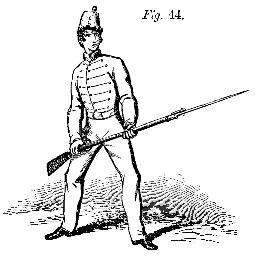
Shoulder - ARMS.
One time and one motion.
Throw up the piece with the left hand, and place it against the right shoulder, at the same time bring the right heel by the side of the left and face to the front.
1. Guard against Cavalry. 2. GUARD.
One time and two motions.
Both motions the same as for guard against infantry, except that the right hand will be supported against the hip, and the bayonet held at height of the eye, as in charge bayonet.
Shoulder - ARMS.
One time and one motion.
Spring up the piece with the left hand and place it against the right shoulder, at the same time bring the right heel by the side of the left, and face to the front.
MANUAL OF THE SWORD OR SABRE, FOR OFFICERS.
POSITION OF THE SWORD OR SABRE, UNDER ARMS.
198. The carry. The gripe in the right hand, which will be supported against the right hip, the back of the blade against the shoulder.
TO SALUTE WITH THE SWORD OR SABRE.
Three times (or pauses).
One.
At
the distance of six paces from the person to be saluted, raise the sword
or sabre perpendicularly, the point up, the flat of the blade opposite
to the right eye, the guard at the height of the shoulder, the elbow supported
on the body.
Two.
Drop the point of the sword or sabre by extending the arm, so that the
right hand may be brought to the side of the right thigh, and remain in
that position until the person to whom the salute is rendered shall be
passed, or shall have passed, six paces.
Three.
Raise
the sword or sabre smartly, and resume the position first prescribed.
COLOR-SALUTE.
199. In the ranks, the color-bearer, whether at a halt or in march, will
always carry the heel of the color-lance supported at the right hip, the
right hand generally placed on the lance at the height of the shoulder,
to hold it steady. When the color has to render honors, the color-bearer
will salute as follows
At
the distance of six paces slip the right hand along the lance to the height
of the eye; lower the lance by straightening the arm to its fullest extent,
the heel of the lance remaining at the hip, and bring back the lance to
the habitual position when the person saluted shall be passed, or shall
have passed, six paces.
-------
PART THIRD.
200. When the men are well established in the principles and mechanism of the step, the position of the body, and the manual of arms,the instructor will unite from eight to twelve in a squad, in order to teach them the principles of alignment, the touch of the elbow in marching to the front, the principles of the march by the flank, wheeling from a halt, wheeling in marching, and the change of direction to the side of the guide. He will place the squad in one rank elbow to elbow, and number the men from right to left.
Alignments.
201.
The instructor will at first teach the soldiers to align themselves man
by man, in order to make them understand the principles of alignment better;
for this purpose, he will command the two men on the right flank to march
two paces to the front, and having aligned (or dressed) them,
he will cause the remainder of the squad to move up, as may be successively
called, each by his number, as three, four, etc.,
and align (or dress) themselves successively on the line
of the first two men.
Each
man, as designated by his number, will turn his head and eyes to the right,
as directed for eyes right in the first part, and march two
paces forward in quick time, shortening the last step, so as to
find himself about six inches behind the new line, which he ought never
to cross; he will then move up steadily by steps of two or three inches,
the legs straight, to the side of the next man to him on the line, so that,
without throwing the head or the shoulders out of place, he may find himself
in the exact line with the files on his right, and touching elbows with
the nearest one without opening out his arms.
The
instructor seeing the line properly dressed, commands:
FRONT.
At which the men will turn their eyes to the front, and remain firm.
Alignments
to the left will be conducted on the same principles.
202.
When the men shall have learned to dress correctly man by man, without
deranging the head or shoulders, and without jostling, the instructor will
cause the entire squad to dress at once by the command:
Squad right (or left) - DRESS.
At
this the squad, except the two men placed in advance as a basis of alignment,
will move up in quick time, and place themselves on the new
line according to the principles just laid down.
The
instructor will superintend the dressing, and when he sees the greater
number of the squad in their proper places, will command:
FRONT.
The
instructor may afterwards order this or that file
forwardor
back,
designating
each man by his number (or name). The file or files designated, will slightly
turn the head towards the right(or
left),
to
judge how much they ought to move up or back, place themselves on the line
by moving an inch or two at a time, and then turn eyes to the front, without
waiting for any command from the instructor.
203.
Alignments to the rear will be executed on the same principles, the men
stepping back a little beyond the line, and then dressing up according
to the principles laid down in No. 201; the commands of the instructor
are:
Right (or left) backward - DRESS.
To march to the front.
204. The squad being correctly aligned, and the instructor wishing to march it to the front, he will place a well-instructcd man on the right or left, according to the side on which he wishes the guide to be, and command:
1. Squad forward. 2. Guide right (or left). 3. MARCH.
At
the command march, the squad will step off smartly with the
left foot, and will take up quick time, unless otherwise
specially ordered. This rule is general. The guide will take
care to march straight to the front, keeping his shoulders always square
with that line. The men will touch elbows lightly on the side towards the
guide, maintaining the shoulders square to the front, no matter on which
side the guide may be; they should be careful not to open out the left
elbow, or the right arm; that they yield to pressure coming from the side
of the guide, and resist that coming from the side opposite; that they
recover by insensible degrees the touch of the elbow, if lost; and if any
files are before or behind the line, that they correct themselves by shortening
or lengthening the step by almost insensible degrees. It is all important
that the closest attention should be paid to each one of the above directions,
otherwise the men cannot attain proficiency, and when they are advanced
the company drill, it will be impossible to secure promptness or accuracy
in the maneuvers.
205. The men being well established in the principles of the direct march,
the instructor will exercise them in marching obliquely. The squad being
in march, the instructor commands
1. Right (or left) oblique. 2. MARCH.
At
the command march, each man will make a half face to the
right (or left), and will then march straight forward in the new direction.
As the men no longer touch elbows, they will glance along the nearest files,
towards the side to which they are obliquing, and will regulate their steps
so that the right (or left) shoulder shall always be behind the left (or
right) shoulder of their next neighbor on the right (or left), and that
his head shall conceal the heads of the other men on the right (or left).
The men should be careful to preserve the same length of pace, and the
same degree cf obliquity. The guides must always be on the flank towards
which the oblique takes place.
The
instructor wishing to resume the direct march, will command:
1. Forward. 2. MARCH.
At the command march, each man will make a half face to the left (or right), and all will march straight to the front, conforming the principles laid down for marching to the front.
To march to the front in double quick time.
206. Instruction in the principles of this step is recommended for all
infantry troops; it may be omitted for infantry of
the line,
but in no other case; nothing but the imperative necessity
for giving all of the time at the disposal of the instructor to instruction
in the principles of the quick step and to the maneuvers, should prevent
even infantry of the line from being thoroughly instructed in the principles
of this step.
The
squad being at a march in quick time, the instructor commands:
1. Double quick. 2. MARCH.
At
the command march, which will be given when either foot is
coming to the ground, the squad will step off in double quick time. The
men should be careful to follow the rules already laid down for the march
in the double quick step, and to preserve the alignment.
When
the instructor wishes the squad to resume the quick step, he will command:
1. Quick time. 2. MARCH.
At
the command march, which should be given when either foot
is coming to the ground, the squad will retake the step in quick time.
If
the squad is at a halt, and the instructor wishes to march at the double
quick step, be commands:
1. Squad forward. 2. Guide right (or left). 3. Double quick. 4. MARCH.
The
squad being on the march in double quick time, the instructor will occasionally
cause it to mark time; the men will then mark double quick time without
altering the cadence. He will also cause them to pass from the direct to
the oblique march, and the reverse, conforming to what has been prescribed
for the oblique march.
In
marching at double quick time, the men will always carry
their pieces on the right shoulder, or at a trail.
This rule is general.
If
the instructor wishes the pieces carried at a trail, he will give the command
trail
arms, before the command double quick. If, on the
contrary, this command is not given, the men will shift their pieces to
the right shoulder at the command double quick. In either
case, at the command halt, the men will bring their pieces to the position
of shouldered arms. This rule is general.
To face about in marching.
207. If the squad be marching in quick, or double quick time, and the instructor should wish to march in retreat, he will command:
1. Squad right about. 2. MARCH.
At the command march, which should be given at the instant the right foot touches the ground, the soldier will complete the next pace with the left foot, then turning to the right about on both heels, will step off with the left foot.
To march by the flank.
208. The squad being at a halt, and correctly aligned, the instructor will command:
1. Squad, right - FACE. 2. Forward. 3. MARCH.
At
the command face, the squad will face to the right; the even
numbered men, after falling to the right, will step quickly to the right
side of the odd numbered men, the latter standing fast so that when the
movement is executed, the men will be formed into files of two men abreast,
or doubled.
At
the command march, the squad will step off smartly with the
left foot; the files keeping their dress, and preserving their intervals.
The
march by the left flank will be executed by the same commands, substituting
the word left for right, and by inverse means;
in this case, the even numbered men, after facing to the left, will stand
fast, and the odd numbered will place themselves on their left.
When
the instructor shall wish to halt the squad, marching by the flank, and
to cause it to face to the front, he will command:
1. Squad. 2. HALT. 3. FRONT.
At
the second command the rank will halt, and afterwards no man will stir,
although he may have lost his distance. This prohibition is necessary,
to habituate the men to a constant attention to their distances.
At
the command front, each man will front by facing to the left,
if marching by the right flank, and by a face to the right, if marching
by the left flank. The rear rank men will move quickly into their places,
so as to form the squad into one rank again.
209.
The squad being on the march by the flank, the instructor will cause it
to change direction by commanding:
1. By fileleft (or right). 2. MARCH.
At
the command march, the first file will change direction to
the left (or right) in describing a small arc of a circle, and will then
march straight forward; the two men of this file, in wheeling, will keep
up the touch of the elbows, and the man on the side to which the wheel
is made, will shorten the first three or four steps. Each file will come
successively to the wheel on the same spot where that which preceded it
wheeled.
210.
The instructor will also cause the squad to face by the right or left flank
in marching, and for this purpose will command:
1. Squad bythe right (or left) flank. 2. MARCH.
At
the command march, which will be given a little before either
foot comes to the ground, the men will turn the body, plant the foot that
is raised in the new direction, and step off with the other foot without
altering the cadence of the step. When the squad faces to the front or
rear in marching, the men who find themselves in rear step
to the right or left so as to form a single rank, each man in his place
as in the beginning; this is called the undoubling of files.
If
when the squad is marching to the front or rear, the instructor causes
it to march by a flank, the files will double; when the squad
is on the march to the front, and is faced by the right flank, the evennumbers
will step up to the right of the odd ones, as in the first
instance in facing from a halt; when it is marched by the left flank, the
odd
numbers should double on the left of the even; if the squad
is marching to the rear when it is faced by the right flank, the odd
will double on the evenas in the last case, but if faced
by the left flank the even will double to the right of the odd
as in the first case.
The
instructor will sometimes march by a flank without doubling files; for
this purpose he commands:
In one rank, right - FACE.
In marching at the double quick, however, the flies will always be doubled.
General principles of wheelings.
211. Wheelings are of two kinds; from a halt, or on fixed pivots,
and on the march, or on a movable pivot.
In
wheelings from a halt, the pivot-man only turns in his place, without advancing
or receding. In the wheels in marching, the pivot-man takes steps of nine
or eleven inches, according as the squad is marching in quick or double
quick time, so as to clear the wheeling point, which is necessary in order
that, in a column column composed of sections, platoons, or companies,
the distances between the different parts of it shall not be lost, as will
be more fully explained in the school of the company.
The
man on the wheeling flank will take a full pace of twenty-eight, or thirty-three
inches, according to whether the time is quick or double quick.
Wheeling from a halt, or on a fixed pivot.
212. The squad being at a halt, the instructor will place a well-instructed man on the wheeling flank to conduct it, and command:
1. By squad, right wheel. 2. MARCH.
At
the command march, the squad will step off with the left
foot, turning the head at the same time a little to the left, the eyes
on the line of the eyes of the men to their left; the pivot-man will merely
mark time, gradually turning his body, in order to conform himself to the
movements of the marching flank; the man who conducts this flank will take
steps of twenty-eight inches, and from the first step advance the left
shoulder a little, cast his eyes from time to time along the rank, and
feel constantly, but lightly, the elbow of the next man on his right, but
never push him. The other man will feel lightly the elbow of the next man
to his right, resist pressure coming from the left, and yield to any coming
from the right; each man will conform himself to the march of the men on
the left, shortening his step more and more as he is nearer the right,
or pivot.
The
instructor will make the squad wheel round the circle once or twice before
halting, in order to cause the principles to be better understood, and
he will he watching that the centre does not break or get too far in advance.
He
will cause the wheel to the left to be executed on the same principles.
When
the instructor wishes to arrest the wheel, he commands:
1. Squad. 2. HALT.
At the second command the squad will halt, and no man stir. The instructor going to the left (or right, if the wheel has been to the left) flank, will place the two outer men of that flank in the direction he may wish to give to the squad, without however displacing the pivot, who will conform the line of his shoulders to this direction. The instructor will take care to have between these two men and the pivot, only the space necessary to contain the other men. He will then command:
Left (or right) - DRESS.
At this the squad will place itself on the alignment of the men fixed as the bases, in conformity with the principles laid down for the alignments. As soon as the men are aligned, the instructor commands:
FRONT.
Wheeling in marching, or on a movable pivot.
213.
When the men have been brought to execute the wheel from a halt properly,
they will be taught the wheel in marching.
For
this end, the squad being on the march, when the instructor shall wish
to cause it to change direction to the flank opposite the guide, he will
command:
1. Right (or left) wheel. 2. MARCH.
The
first command will be given when the squad is four paces
from the wheeling point.
At
the command march, the wheel will be executed in the same
manner as from a halt, except that the touch of the elbow will remain towards
the left or marching flank, instead of the side of the actual
pivot; that the pivot-man, instead of merely turning in his place, will
conform himself to the movement of the marching flank, feel lightly the
elbow of the next man, take steps of full nine inches, and thus gain ground
forward so as to clear the point of the wheel. The middle, of the rank
will bend slightly to the rear. As soon as the movement shall commence,
the man who conducts the marching flank will cast his eyes on the ground
over which he will have to pass.
The
wheel being ended, the instructor will command:
1. Forward. 2. MARCH.
The
command forward will be given four paces before
the wheel is complete.
At
the command march, which will begin at the instant the wheel
is complete, the man who conducts the wheel will march straight forward;
the pivot man and all the rest of the squad will retake the step of twenty-eight
inches, and bring the head direct to the front.
Turning, or change of direction to the side of the guide.
214. The change of direction to the side of the guide, in marching, will be executed as follows: the instructor will command:
1. Left (or right) turn. 2. MARCH.
The
first command should be given when the squad is four paces
from the turning point.
At
the command march, to be pronounced at the instant the rank
ought to turn, the guide will face to the left (or right) in marching,
and move forward in the new direction without changing the pace. The whole
squad will promptly conform to the new direction; to effect which, each
man will advance the shoulder opposite the guide, take the double quick
step, turn the head and eyes to the side of the guide, place himself on
the line with the guide, from whom he will take the step, touch elbows
to the side of the guide, and resume the direct position of the head. The
men will arrive in their places in regular succession.
215.
When the men comprehend, and can execute the various wheels, etc., in quick
time, the instructor will cause them to be repeated in double quick time,
by the same commands, and according to same principles as in quick time,
except that the command double quick will precede that of
march.
In
wheeling while marching, the pivot man will take steps of eleven inches,
and in the changes of direction to the side of the guide, the men on the
side opposite the guide must increase the gait in order to bring themselves
into line.
The
instructor, in order not to fatigue the men, and not to divide their attention,
will cause them to execute the several movements of wheelings, etc., first
without arms, and next, after the mechanism be well comprehended, with
arms.
ARTICLE II. CONTENTS. ARTICLE IV.